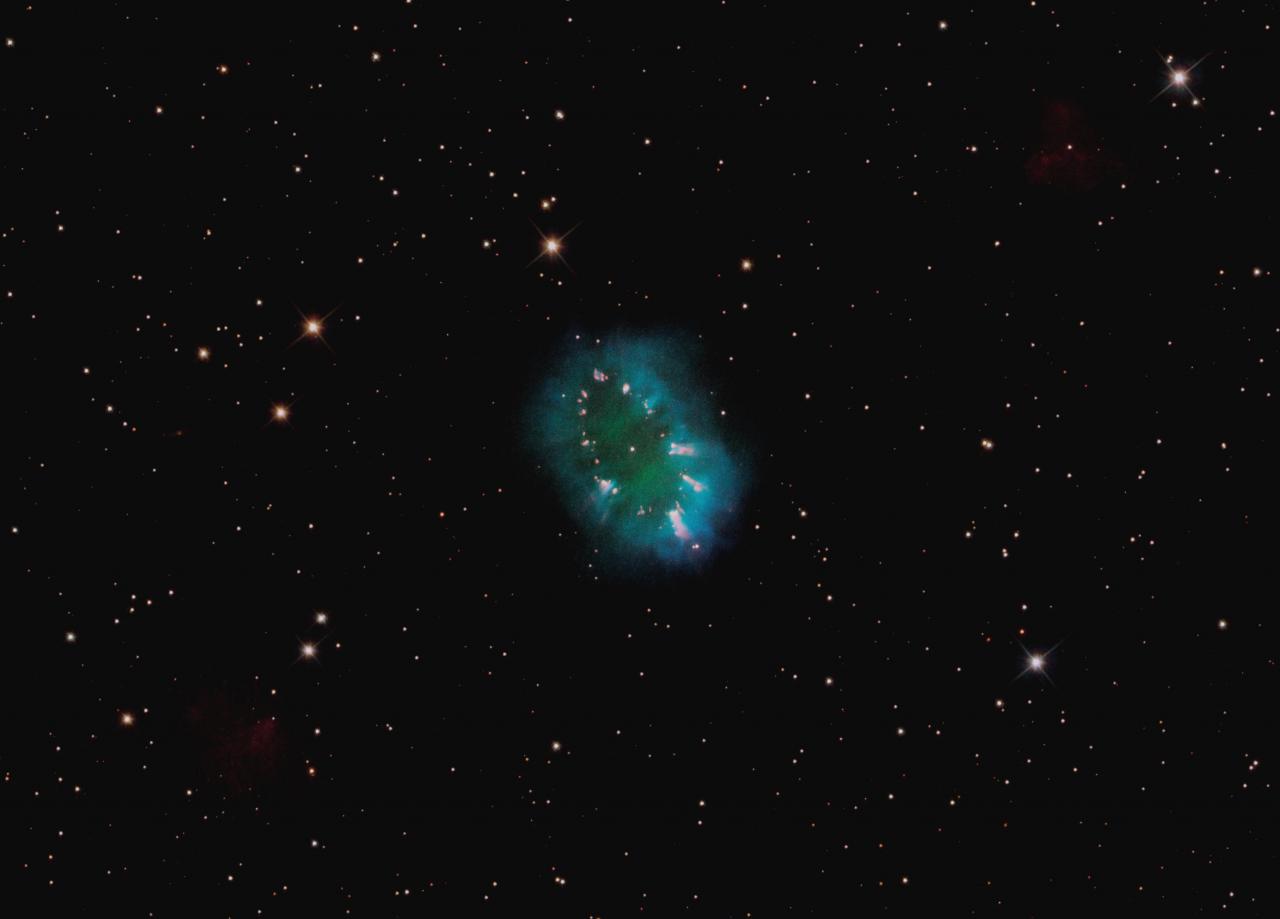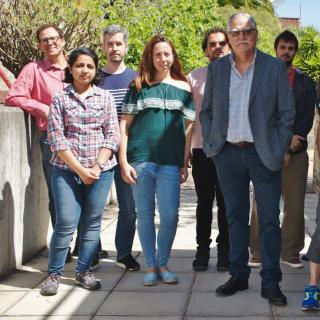General
This project has three major objectives: 1) To determine the physico-chemical characteristics of bipolar planetary nebulae and symbiotic nebulae, to help understanding the origin of bipolarity and to test theoretical models, mainly models with binary central stars, aimed at explaining the observed morphology and kinematics. 2) To study the low-ionization microstructures in planetary nebulae, their origin (in the context of the main shell formation), their physico-chemical characteristics, and their interaction with the nebular gas. 3) To discover and study galactic and extragalactic planetary nebulae, analyzing their physico-chemical properties and the metallicity gradients along the galactic discs.
Members
Results
Miszalski, B and collaborators (2016, MNRAS, 456, 633) re-discovered a dwarf nova system, an eruption of which was first observed by ancient Chinese astronomers in the year 483 CE. Hillwig, T and collaborators (2016, ApJ, 832, 125) demonstrated that the symmetry axes of planetary nebulae with binary central stars always lie perpendicular to the orbital plane of the central binaries. The probability of encountering such a tight correlation by chance is less than a million to one.
Scientific activity
Related publications
-
The Chemistry of Planetary Nebulae in the Outer Regions of M31
We present spectroscopy of nine planetary nebulae (PNe) in the outskirts of M31, all but one obtained with the 10.4 m GTC telescope. These sources extend our previous study of the oxygen abundance gradient of M31 to galactocentric radii as large as 100 kpc. None of the targets are bona fide members of a classical, metal-poor, and ancient halo. Two
Hensley, K. et al.Advertised on:
72015 -
New OB star candidates in the Carina Arm around Westerlund 2 from VPHAS+
O and early B stars are at the apex of galactic ecology, but in the Milky Way, only a minority of them may yet have been identified. We present the results of a pilot study to select and parametrize OB star candidates in the Southern Galactic plane, down to a limiting magnitude of g = 20. A 2 deg2 field capturing the Carina Arm around the young
Mohr-Smith, M. et al.Advertised on:
72015 -
Witnessing the emergence of a carbon star
During the late stages of their evolution, Sun-like stars bring the products of nuclear burning to the surface. Most of the carbon in the Universe is believed to originate from stars with masses up to a few solar masses. Although there is a chemical dichotomy between oxygen-rich and carbon-rich evolved stars, the dredge-up itself has never been
Guzman-Ramirez, L. et al.Advertised on:
72015 -
Binarity and the Abundance Discrepancy Problem in Planetary Nebulae
The discrepancy between abundances computed using optical recombination lines and collisionally excited lines is a major unresolved problem in nebular astrophysics. Here, we show that the largest abundance discrepancies are reached in planetary nebulae with close binary central stars. We illustrate this using deep spectroscopy of three nebulae with
Corradi, R. L. M. et al.Advertised on:
42015 -
Co-spatial Long-slit UV/Optical AL Spectra of 10 Galactic Planetary Nebulae with HST/STIS. I. Description of the Observations, Global Emission-line Measurements, and CNO Abundances
We present observations and initial analysis from a Hubble Space Telescope (HST) Cycle 19 program using STIS to obtain the first co-spatial, UV–optical spectra of 10 Galactic planetary nebulae (PNs). Our primary objective was to measure the critical emission lines of carbon and nitrogen with unprecedented signal-to-noise ratio (S/N) and spatial
Dufour, R. J. et al.Advertised on:
42015 -
The double-degenerate, super-Chandrasekhar nucleus of the planetary nebula Henize 2-428
The planetary nebula stage is the ultimate fate of stars with masses one to eight times that of the Sun (). The origin of their complex morphologies is poorly understood, although several mechanisms involving binary interaction have been proposed. In close binary systems, the orbital separation is short enough for the primary star to overfill its
Santander-García, M. et al.Advertised on:
32015 -
The Chandra Planetary Nebula Survey (ChanPlaNS). III. X-Ray Emission from the Central Stars of Planetary Nebulae
We present X-ray spectral analysis of 20 point-like X-ray sources detected in Chandra Planetary Nebula Survey observations of 59 planetary nebulae (PNe) in the solar neighborhood. Most of these 20 detections are associated with luminous central stars within relatively young, compact nebulae. The vast majority of these point-like X-ray-emitting
Montez, R., Jr. et al.Advertised on:
22015 -
A hydrodynamical study of multiple-shell planetary nebulae. III. Expansion properties and internal kinematics: Theory versus observation
We present the result of a study on the expansion properties and internal kinematics of round/elliptical planetary nebulae of the Milky Way disk, the halo, and of the globular cluster M 15. The purpose of this study is to considerably enlarge the small sample of nebulae with precisely determined expansion properties (Schönberner et al. \cite{SJSPCA
Schönberner, D. et al.Advertised on:
52014 -
Constraining the shaping mechanism of the Red Rectangle through the spectro-polarimetry of its central star
We carried out high-sensitivity spectro-polarimetric observations of the central star of the Red Rectangle protoplanetary nebula with the aim of constraining the mechanism that gives its biconical shape. The stellar light of the central binary system is linearly polarised since it is scattered on the dust particles of the nebula. Surprisingly, the
Martínez González, M. J. et al.Advertised on:
22015 -
Gas physical conditions and kinematics of the giant outflow Ou4
Context. The recently discovered bipolar outflow Ou4 has a projected size of more than one degree in the plane of the sky. It is apparently centred on the young stellar cluster - whose most massive representative is the triple system HR 8119 - inside the H ii region Sh 2-129. The driving source, the nature, and the distance of Ou4 are not known
Corradi, R. L. M. et al.Advertised on:
102014 -
The Chandra Planetary Nebula Survey (CHANPLANS). II. X-Ray Emission from Compact Planetary Nebulae
We present results from the most recent set of observations obtained as part of the Chandra X-ray observatory Planetary Nebula Survey (CHANPLANS), the first comprehensive X-ray survey of planetary nebulae (PNe) in the solar neighborhood (i.e., within ~1.5 kpc of the Sun). The survey is designed to place constraints on the frequency of appearance
Freeman, M. et al.Advertised on:
102014 -
The second data release of the INT Photometric Hα Survey of the Northern Galactic Plane (IPHAS DR2)
The INT/WFC Photometric Hα Survey of the Northern Galactic Plane (IPHAS) is a 1800 deg2 imaging survey covering Galactic latitudes |b| < 5° and longitudes ℓ = 30°-215° in the r, i, and Hα filters using the Wide Field Camera (WFC) on the 2.5-m Isaac Newton Telescope (INT) in La Palma. We present the first quality-controlled and globally calibrated
Barentsen, G. et al.Advertised on:
112014 -
First release of the IPHAS catalogue of new extended planetary nebulae
We present the first results of our search for new, extended planetary nebulae (PNe) based on careful, systematic, visual scrutiny of the imaging data from the Isaac Newton Telescope Photometric Hα Survey of the Northern Galactic plane (IPHAS). The newly uncovered PNe will help to improve the census of this important population of Galactic objects
Sabin, L. et al.Advertised on:
102014 -
Planetary nebulae: the universal mass-metallicity relation for Local Group dwarf galaxies and the chemistry of NGC 205
Here we study 16 planetary nebulae (PNe) in the dwarf irregular galaxy NGC 205 by using Gemini Multi-Object Spectrographs (GMOS@Gemini) spectra to derive their physical and chemical parameters. The chemical patterns and evolutionary tracks for 14 of our PNe suggest that there are no type I PNe among them. These PNe have an average oxygen abundance
Gonçalves, D. R. et al.Advertised on:
102014 -
IPHAS and the symbiotic stars. III. New discoveries and their IR spectral energy distributions
Context. The IPHAS Hα survey provides a rich database to search for emission-line sources in the northern Galactic plane. Aims: We are systematically searching for symbiotic stars in the Milky Way using IPHAS. Our final goal, a complete census of this class of objects in the Galaxy, is a fundamental figure for discussing their overall properties
Rodríguez-Flores, E. R. et al.Advertised on:
72014 -
The planetary nebula IPHASXJ211420.0+434136 (Ou5): insights into common-envelope dynamical and chemical evolution
While analysing the images of the IPHAS (INT/WFC Photometric Hα Survey of the northern Galactic plane) survey, we noticed that the central star of the candidate planetary nebula IPHASXJ211420.0+434136 (also named Ou5) was clearly variable. This is generally considered as an indication of binarity. To confirm it, we performed a photometric
Corradi, R. L. M. et al.Advertised on:
72014 -
Upper Limits to the Magnetic Field in Central Stars of Planetary Nebulae
More than about 20 central stars of planetary nebulae (CSPNs) have been observed spectropolarimetrically, yet no clear, unambiguous signal of the presence of a magnetic field in these objects has been found. We perform a statistical (Bayesian) analysis of all the available spectropolarimetric observations of CSPN to constrain the magnetic fields in
Asensio Ramos, A. et al.Advertised on:
62014 -
The VST Photometric Hα Survey of the Southern Galactic Plane and Bulge (VPHAS+)
The VST Photometric Hα Survey of the Southern Galactic Plane and Bulge (VPHAS+) is surveying the southern Milky Way in u, g, r, i and Hα at ˜1 arcsec angular resolution. Its footprint spans the Galactic latitude range -5o < b < +5° at all longitudes south of the celestial equator. Extensions around the Galactic Centre to Galactic latitudes ±10°
Drew, J. E. et al.Advertised on:
42014 -
A search for magnetic fields on central stars in planetary nebulae
Context. One of the possible mechanisms responsible for the panoply of shapes in planetary nebulae is the presence of magnetic fields that drive the ejection of ionized material during the proto-planetary nebula phase. Aims: Therefore, detecting magnetic fields in such objects is of key importance for understanding their dynamics. Still, magnetic
Leone, F. et al.Advertised on:
32014 -
The post-common-envelope, binary central star of the planetary nebula Hen 2-11
We present a detailed photometric study of the central star system of the planetary nebula Hen 2-11, selected for study because of its low-ionisation filaments and bipolar morphology - traits which have been strongly linked with central star binarity. Photometric monitoring with NTT-EFOSC2 reveals a highly irradiated, double-eclipsing, post-common
Tyndall, A. A. et al.Advertised on:
22014



